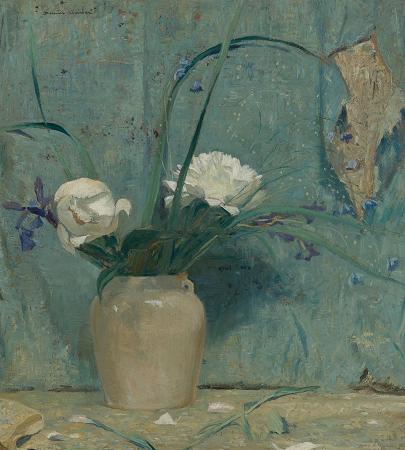Peony. The peony or paeony is a flowering plant in the genus Paeonia, the only genus in the family Paeoniaceae. They are native to Asia, Europe and Western North America. Scientists differ on the number of species that can be distinguished, ranging from 25 to 40, although the current consensus is 33 known species. The relationships between the species need to be further clarified. Most are herbaceous perennial plants 0.25-1 metre tall, but some are woody shrubs 0.25-3.5 metres tall. They have compound, deeply lobed leaves and large, often fragrant flowers, in colors ranging from purple and pink to red, white or yellow, in late spring and early summer. The flowers have a short blooming season, usually only 7-10 days. Peonies are among the most popular garden plants in temperate regions. Herbaceous peonies are also sold as cut flowers on a large scale, although generally only available in late spring and early summer. An emerging source of peonies in mid to late summer is the Alaskan market. Unique growing conditions due to long hours of sunlight create availability from Alaska when other sources have completed harvest. All Paeoniaceae are deciduous perennial herbs or shrubs, with thick storage roots and thin roots for gathering water and minerals. Some species are caespitose, because the crown produces adventitious buds, while others have stolons. They have rather large compound leaves without glands and stipules, and with anomocytic stomata. In the woody species the new growth emerges from scaly buds on the previous flush or from the crown of the rootstock. The large bisexual flowers are mostly single at the end of the stem. In P. emodi, P. lactiflora, P. veitchii and many of the cultivars these contributed to, few additional flowers develop in the axils of the leaves. Flowers close at night or when the sky is overcast. Each flower is subtended by a number of bracts, that may form a sort of involucre, has 3-7 tough free sepals and mostly 5-8, but occasionally up to 13 free petals. These categories however are intergrading, making it difficult to assign some of them, and the number of these parts may vary. Within are numerous free stamens, with anthers fixed at their base to the filaments, and are sagittate in shape, open with longitudal slits at the outer side and free pollen grains which have three slits or pores and consist of two cells. Within the circle of stamens is a more or less prominent, lobed disc, which is presumed not to excrete nectar. Within the disk is a varying number of separate carpels, which have a very short style and a decurrent stigma. Each of these develops into a dry fruit, which opens with a lengthwise suture and each of which contains one or a few large fleshy seeds. The annual growth is predetermined: if the growing tip of a shoot is removed, no new buds will develop that season. Paeoniaceae are dependent on C3 carbon fixation. They contain ellagic acid, myricetin, ethereal oils and flavones, as well as crystals of calcium oxalate. The wax tubules that are formed primarily consist of palmitone. The basic chromosome number is five. About half of the species of the section Paeonia however is tetraploid, particularly many of those in the Mediterranean region. Both allotetraploids and autotetraploids are known, and some diploid species are also of hybrid origin. The family name Paeoniaceae was first used by Friedrich K.L. Rudolphi in 1830, following a suggestion by Friedrich Gottlieb Bartling that same year. The family had been given other names a few years earlier. The composition of the family has varied, but it has always consisted of Paeonia and one or more genera that are now placed in Ranunculales. It has been widely believed that Paeonia is closest to Glaucidium, and this idea has been followed in some recent works. Molecular phylogenetic studies, however, have demonstrated conclusively that Glaucidium belongs in the family Ranunculaceae, order Ranunculales, but that Paeonia belongs in the unrelated order Saxifragales.
more...







